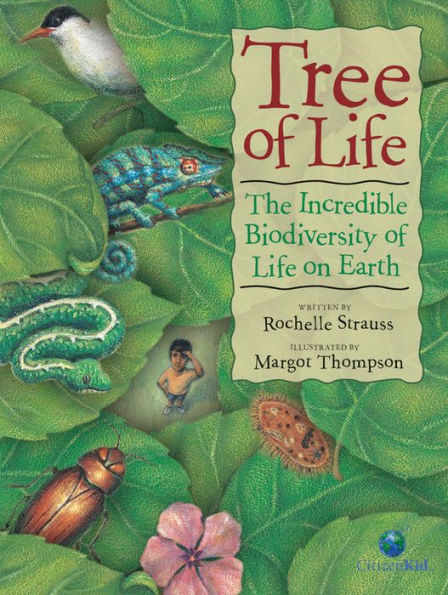Striking, lucid, and deceptively simple.—School Library Journal
Tree of Life is beautifully designed, and Thompson's realistic pictures bring the Earth's creatures vividly to life. ... some of the vocabulary will prove challenging for readers as young as eight. Older children will nevertheless find this a wonderfully helpful resource.—Quill & Quire
This introduction to the five kingdoms of living things does an excellent job of helping young readers understand how scientists organize and classify all living things. ... Large-sized, both handsome and useful, this is an outstanding collaboration of author and illustrator.—Kirkus Reviews
Several titles delve into an exploration of the environment. A family tree metaphor serves as the basis of Tree of Life: The Incredible Biodiversity of Life on Earth by Rochelle Strauss, illus. by Margot Thompson, which presents the entirety of life on Earth, incorporating branches devoted to Monera (bacteria), Fungi and more. Strauss explains the traits of the different divisions, dissects them further (e.g., animals to vertebrates to amphibians to frogs, salamanders, etc.) and offers unique facts about particular species. Thompson's "crackled" illustrations depict species as the leaves on the Tree of Life. Copyright 2004 Reed Business Information.
The world's biodiversity is organized here so that upper elementary school readers can get a handle on how science classifies living species. Presently there are five main branches, or kingdoms, each getting a double page spread: Monera, Fungi, Protoctista, Plants and Animals. The animals are further subdivided into invertebrates and vertebrates which are further subdivided. While the term "kingdom" is used, the book skips other terms of systematic classification and jumps to specific examples of species to make the topic easily understandable. Each double page spread is easily read, format supports understanding of groups, and following each short paragraph explaining the reptiles, for instance, are five or six paragraphs with anecdotes. the approximate numbers of species (4320 lizards, 3300 snakes, and so forth). Thompson's painted renderings suggest the diversity without visually overpowering. This is the book for readers to return to as they begin to notice similarities and differences among species, and want to feel some control over the planet's biology. Simplifying a complex subject and clearly delineating the content, the book ends with five ways one can guard biodiversity and a double page of ideas for teachers and adults to consider in opening a dialog but the book certainly stands on its own. Indexed. 2004, Kids Can Press, Ages 8 to 12.
—Susan Hepler, Ph.D.
Gr 5-7-A handsome presentation in a slender, oversized format, generously illustrated with impressive, informative acrylics. Strauss's clearly written text first introduces the concept of a family tree for all living things, then goes on to name the five kingdoms of scientific classification (those programmed for "Protists" will have to adapt to "Protoctista" here). On two-page spreads, the author describes the life-forms included in each species, with specific examples shown in the softly colorful illustrations accompanied by informative captions. The Animal Kingdom comprises the longest segment as it is broken down into invertebrates and vertebrates, with the latter divided still further into fish, birds, and so on. Two closing units discuss habitat loss and its effect on biodiversity, and how one can protect the environment. A final entry aimed at "Parents, Teachers and Guardians" explains the history of scientific classification, discusses the importance of biodiversity to this planet, and provides some suggestions for fostering a biodiversity ethic in young people. This book might be paired with Steve Jenkins's equally attractive Life on Earth (Houghton, 2002) to demonstrate just how biodiversity became such a rich, multilayered conglomeration. Striking, lucid, and deceptively simple.-Patricia Manning, formerly at Eastchester Public Library, NY Copyright 2004 Reed Business Information.
This introduction to the five kingdoms of living things does an excellent job of helping young readers understand how scientists organize and classify all living things. For each kingdom, the author provides a brief introduction, an estimate of the number of species in the kingdom, and thumbnail sketches of unusual or illustrative species. She is quick to acknowledge that scientists continue to discover new species and re-evaluate and classify existing ones. Science enthusiasts will relish the astronomical numbers and odd facts, for example, "there are 350,000 known species of beetles," and the world's oldest and heaviest fungi, found in a Michigan forest weighs more than an elephant. The illustrator continues the metaphor of the tree of life by capturing individual species laid out on a leaf, and using an icon of a tree throughout with a portion of leaves highlighted to note the relative number of species in each kingdom. Large-sized, both handsome and useful, this is an outstanding collaboration of author and illustrator. (note to teachers and parents, index) (Nonfiction. 9-12)
Tree of Life is beautifully designed, and Thompson’s realistic pictures bring the Earth’s creatures vividly to life. ... some of the vocabulary will prove challenging for readers as young as eight. Older children will nevertheless find this a wonderfully helpful resource.



